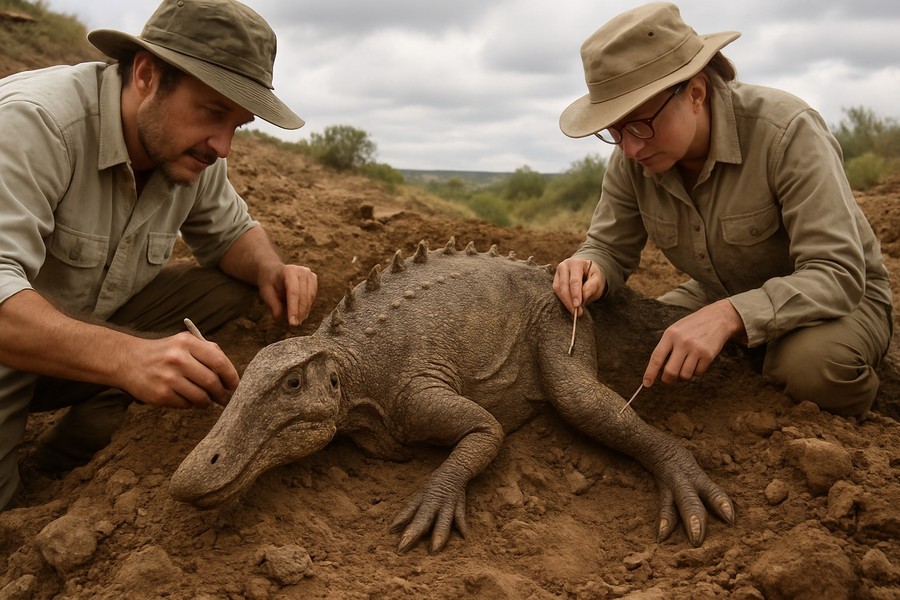
Revolutionary Discovery of Dinosaur 'Mummies' Unveils a New Level of Details
Imagine a time period over 66 million years ago when a particular type of dinosaur, known for its duck-like bill, roamed the earth. This creature, a plant-eating dinosaur, left behind something extraordinary.
Upon reexamination of its fossil remains discovered in Wyoming, scientists were stunned to find not just ordinary bones. Instead, they found traces of a thin clay mask that preserved the dinosaur's skin, spikes, and even its hooves. This exciting find has reshaped preconceived notions about dinosaur "mummies."
Understanding Duck-Billed Dinosaurs
The duck-billed dinosaurs, also referred to as hadrosaurs, were some of the most prevalent herbivores during the Late Cretaceous period, roughly 75 to 65 million years ago. They were known for their broad, flat snouts, resembling a duck’s bill, which enabled them to strip leaves and vegetation from trees and shrubs efficiently.
Inside their mouths, they boasted hundreds of compact teeth that functioned like an enormous grinding machine, ideal for consuming tough plant matter. In fact, their teeth were so efficient that scientists consider hadrosaurs some of the most advanced herbivores of their era.
Unique Preservation of Duck-Billed Dinosaurs
Unlike typical fossilization that occurs in oxygen-deprived lagoons or lakebeds, this duck-billed dinosaur was buried in sandy river channels. After death, its carcass dried in the sun before being swept up in a sudden flood.
As the body decomposed, microbes on its surface formed a thin biofilm that attracted clay minerals from the surrounding sediment. This resulted in a submillimeter-thick layer, called a clay template, that captured every wrinkle and scale before the flesh itself disappeared.
One researcher expressed excitement over this discovery, noting that the badlands in Wyoming, where the finds were made, is a unique 'mummy zone' that likely holds more surprises.
Detailed Mummies of Dinosaurs
Using cutting-edge imaging, the researchers reconstructed the dinosaur's body in exceptional detail. A tall, fleshy crest stretched from its neck down to its back, fading into a neat row of interlocking spikes along the tail. The skin bore intricate polygonal scales, some barely a few millimeters wide.
These features suggest a flexible, textured hide rather than thick armor. The preservation of such fine surface detail supports the clay templating theory, which shows how biofilms can replicate soft anatomy even in oxygen-rich environments.
The two specimens provided complementary information, allowing researchers to see the full profile instead of scattered patches.
Revelations about Duck-Billed Dinosaur's Hooves
Perhaps the most astonishing revelation was beneath the feet. CT scans revealed wedge-shaped hooves with flat bottoms encasing the dinosaur's toes.
This discovery makes this duck-billed dinosaur the earliest known hooved reptile and the first land vertebrate with different foot postures between front and back limbs. The front limbs bore hooves that touched the ground, while the hind limbs combined hooves with fleshy heel pads, enabling both bipedal and quadrupedal movement.
One of the researchers remarked on the amazing 'firsts' preserved in these dinosaur mummies, including the earliest documented hooves in a land vertebrate, the first confirmed hooved reptile, and the first four-legged hooved animal with different forelimb and hindlimb posture.
A Natural Dinosaur Mummy
The researchers outlined a four-stage process of natural mummification. Initially, desiccation occurred under dry conditions, followed by a sudden flood that buried the carcass. Then, the body cavities filled rapidly with sediment while a thin biofilm formed on its surface. Lastly, the clay minerals adhered to this biofilm, forming the mask that preserved the outer form before the tissues dissolved. Within weeks, the skeleton fossilized beneath its clay imprint.
This process, known as terrestrial clay-templated preservation, differs from classic fossilization where mineralization replaces soft tissue. Instead, the clay acts as a natural mold, maintaining the outer structure long after the organic matter disappears. Over time, pressure and heat further solidified the sediment, protecting every contour of the animal’s body.
This rare sequence of events explains why such detailed fossils are almost never found in river settings, making this discovery one of the most exceptional finds in paleontology.
Fossil-Rich Mummy Zone
The Wyoming “mummy zone,” less than ten kilometers wide, continues to yield well-preserved fossils of various dinosaurs. Researchers attribute this to the region’s rapid geological subsidence and alternating drought-flood cycles near a Cretaceous coastline. These unique conditions created perfect opportunities for clay templating to occur repeatedly over time.
The discoveries made thus far represent an important breakthrough in understanding the ancient language of fossils. This new understanding reveals not only the shapes of vanished creatures but also the delicate processes that preserved their final moments in clay.
